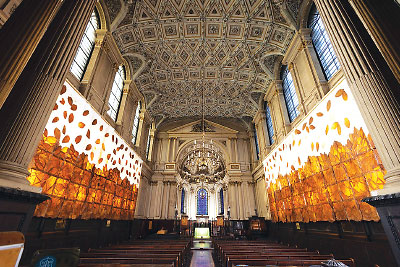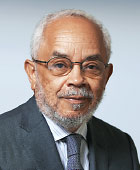On a stroll around London, I found myself standing at the entrance to an aging Anglican church named
St. Mary le Strand. The building I was admiring had been constructed in the early 1700s. I was fascinated by its location—it sat on a separate parcel of land in the middle of a wide city street. Bustling life moved in all directions, while the edifice seemed unperturbed by the noisy modernity infringing on its boundaries. I have long thought it good for cities to have institutions in their midst that resist quietly the relentless march of footsteps. I noted, with some pleasure, that this church was unlocked and inviting passers-by to enter and visit its art exhibition.
The lady who greeted me encouraged me warmly to look around. And seeing my serious interest in the church and what went on there, she introduced me to the Priest-in-Charge, the Rev. Dr. Peter Babington. He explained that St. Mary was constructed on the Royal Processional Route that extends from the Palace of Westminster to the city of London and St. Paul’s Cathedral. Located in Westminster along with the Houses of Parliament and Buckingham Palace, St. Mary has enjoyed the benefits of its geography. It has also been at the whims of developments attending many institutions caught in the grips of increasing urban spread. Churches, particularly, feel the effects when congregants quit the city searching for a different kind of life. Those who remain behind sometimes worry that the burden is a bit heavier and the organizational mission more complex.
A slight despondency set in when I heard that for several years St. Mary had no full-time priest. In such circumstances, the expected communitywide debate was unavoidable—the one about whether the church should be closed. Fortunately, after the discussions, the Rev. Babington was invited in 2020 to take over as Priest-in-Charge. I imagined that the discussions touched factors like those that confront civic leaders when a hospital closure comes up. Is there really a community need? Where will the financial support come from? Rev. Babington and I did not dwell much on these matters. However, he did articulate confidently the church’s new tripartite mission: the church as a place of worship and prayer, the catalytic function of church as a crucial link to other public institutions, and the cultural role of promoting and supporting efforts in the arena of arts and the humanities. Thinking about the hundreds of people I had seen moving around in the streets outside the building, it seemed obvious to me that having a sacred space in the vicinity was necessary.
The Rev. Babington was raised by his Anglican priest father and zoologist mother. After earning his undergraduate degree in applied chemistry, he worked as a chemist for about a year. However, he gradually recognized that both his faith and life vocation were unsettled matters. After several years of contemplation and discussions with friends and advisors, he grew resolute about taking holy orders. He felt his decision to be ordained a priest was buttressed by an epiphanous coming to terms with a verse from the Gospel of Matthew 28:20: “Lo, I am with you always, even unto the end of the world” (King James Version). This prophetic promise of an eternal companion forecast his ordination to the priesthood in 1999. The promise also allowed him to counter my concern about the difficulty of visualizing God’s presence while we are caught up in personal suffering. He pointed out that God does not intervene in our problems with our sense of immediacy. However, He is involved in His own way.
Besides our exchange about his pastoring to the community of St. Mary le Strand, we discussed the artistic collage of tobacco leaves installed on the sides of the sanctuary. Curated by Roberta Semeraro, “Conexión” is the creation of artist-architect Lidia León, who hails from the Dominican Republic. The exposition was a part of the 2019 Venice Art Biennale. Ms. León was raised in a family of Dominican tobacco farmers and is known for her involvement in social causes. She highlights the blending of Caribbean identities and the diversity of individuals’ beginnings.
The tobacco plants represent an important part of agriculture in the Dominican Republic and, in the present installation, are strikingly set against the architecture of St. Mary and the church’s blue stained-glass windows. The photograph of the church’s interior highlights this aspect of the sacred space.
I wish to emphasize the role that chance plays in these encounters. The view of people moving along different axes around the church in a busy street was a geometric puzzle. Within the building, there was this individual, obviously supported by others, trying to make the world a more beautiful and serene place. The light dancing on the suspended tobacco leaves contrasted with the more direct rays coming through the blue stained glass. Since that experience, I have seen the work of Henri Matisse, the modern French painter, who worked so intensely on enhancing the elegance of sacred buildings. There is an especial drive and insight that catalyze this creativity. Bearing witness to the imaginative, on an unplanned basis, is a wonder. It is more captivating than the usual museum visit. ■


